You’ll revolutionize your jewelry design process with 3D printing’s unprecedented freedom to create complex geometries, hollow structures, and interlocking components impossible through traditional methods. You’ll accelerate production from weeks to days while eliminating expensive molds and reducing material waste by up to 90%. The technology enables rapid prototyping for immediate design refinements, cost-effective customization, and precision down to 20-micron layers. Discover how this transformative approach opens up creative possibilities you never imagined.
Unprecedented Design Freedom for Complex Geometries
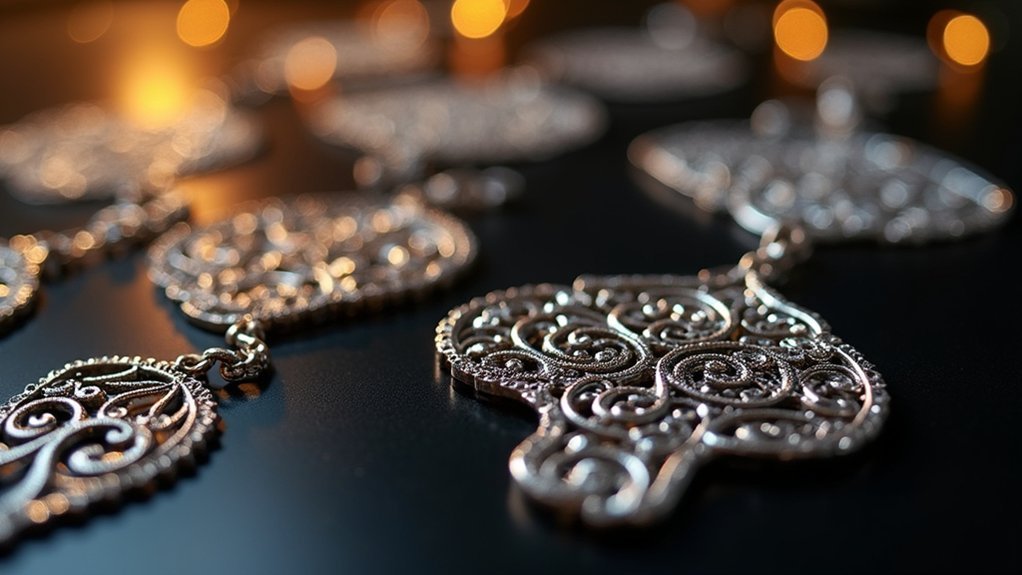
While traditional jewelry-making methods confine you to relatively simple shapes and standard construction techniques, 3D printing shatters these limitations by enabling the creation of complex geometries that were previously impossible to manufacture.
You’re no longer restricted to basic forms—3D printing technology empowers you to craft intricate designs featuring elaborate patterns, intertwining elements, and asymmetrical structures that showcase your artistic vision.
This unprecedented design freedom allows you to experiment with custom jewelry designs that incorporate integrated clasps and interlocking mechanisms directly within the model.
Through rapid prototyping, you can quickly test and refine these complex geometries before final production.
Whether you’re inspired by organic forms or geometric abstractions, 3D printing transforms your boldest concepts into tangible pieces that reflect your unique style and push creative boundaries.
Rapid Prototyping Accelerates Your Creative Process
When you embrace 3D printing for jewelry creation, you’ll discover that rapid prototyping transforms your design workflow from weeks of traditional crafting into hours of iterative refinement.
You can create multiple versions of your jewelry design quickly, identifying flaws before committing to final production. This accelerated process lets you test different approaches to intricate designs that would’ve taken days using conventional methods.
Rapid prototyping also streamlines your material selection process.
Rapid prototyping eliminates guesswork in material choices, letting you test finishes and textures without costly commitments to precious metals.
You’ll experiment with various finishes and textures, making informed decisions without wasting expensive metals or stones. When market trends shift or customers request modifications, you can respond immediately rather than starting from scratch.
This dramatically reduced production time gives you a competitive advantage, allowing you to bring fresh concepts to market while maintaining design quality and meeting customer expectations efficiently.
Cost-Effective Production Without Traditional Tooling
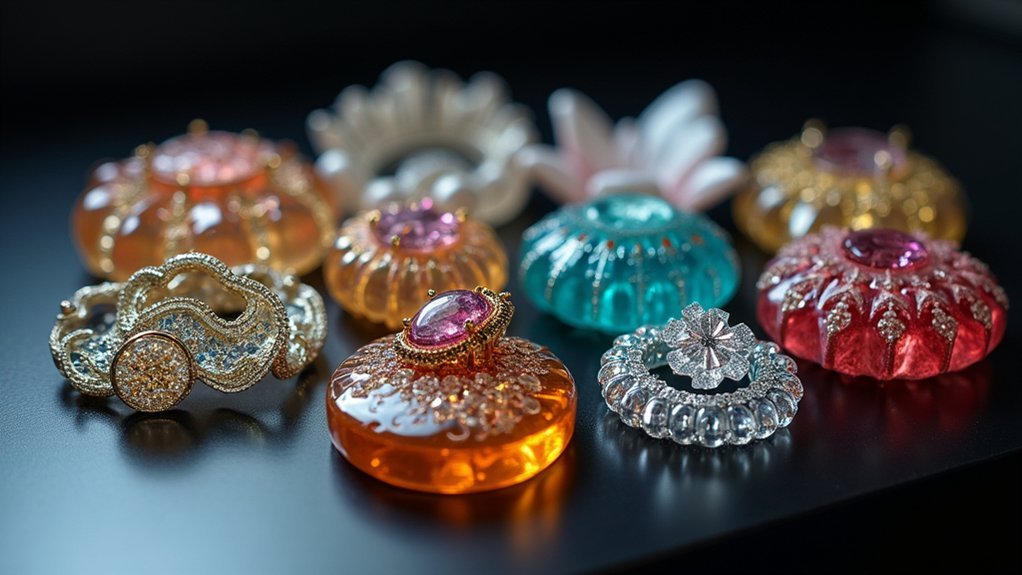
Since 3D printing eliminates expensive molds and tooling requirements, you’ll slash your upfront costs dramatically compared to traditional jewelry manufacturing. This cost-effective production method uses additive manufacturing to minimize material waste while supporting on-demand creation of custom designs.
| Cost Factor | Traditional Manufacturing | 3D Printing |
|---|---|---|
| Initial Setup | High tooling costs | Minimal setup fees |
| Material Usage | Significant waste | Optimized consumption |
| Production Speed | Slower iterations | Rapid prototyping |
| Storage Requirements | Large inventory needs | On-demand creation |
You’ll reduce time-to-market through faster iterations and eliminate overproduction expenses. The flexibility supports low-volume runs, making it economically viable for independent designers to create personalized pieces without financial risk. This approach transforms how you approach custom jewelry production.
Personalization and Customization at Scale
Through 3D printing technology, you can deliver truly personalized pieces that reflect each customer’s unique style and preferences.
You’re no longer limited by traditional manufacturing constraints when creating customized engagement rings or intricate anniversary bands. The freedom to design allows you to meet growing demand for personalization without expensive tooling.
Your design software capabilities enable three key advantages:
- Rapid iterations – You can quickly modify designs based on customer feedback.
- Unique geometries – You’ll create complex patterns impossible with traditional methods.
- Individual specifications – You can incorporate personal engravings and custom dimensions.
3D printing lets you produce at scale while maintaining individuality.
You’ll reduce material waste compared to subtractive manufacturing methods, making sustainable personalization achievable for your jewelry business.
Reduced Material Waste Through Additive Manufacturing
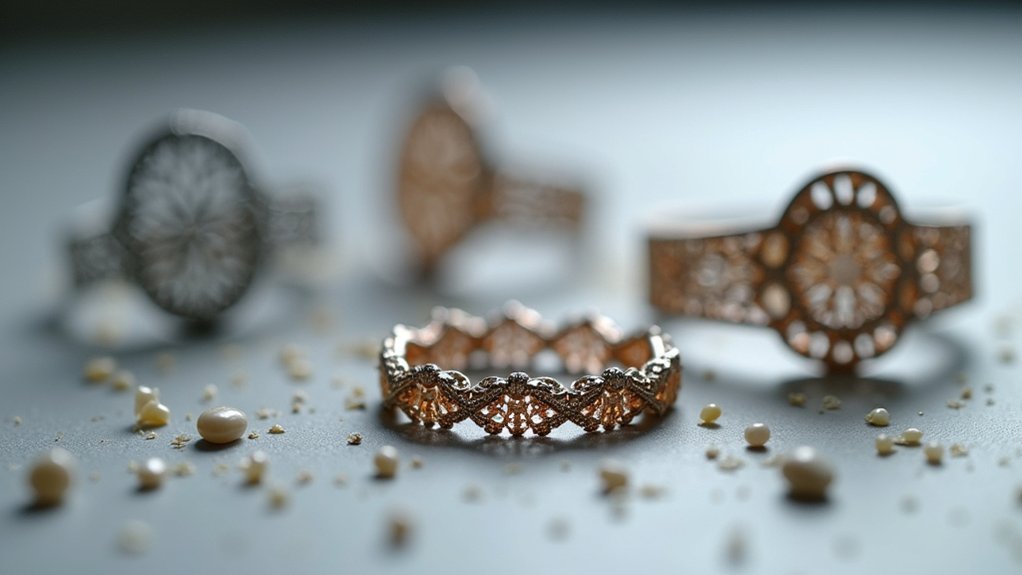
Beyond personalization benefits, 3D printing transforms how you’ll approach material efficiency in jewelry production.
Unlike traditional subtractive manufacturing that cuts away excess material, additive manufacturing uses only what’s necessary to create each piece. This precision reduces material waste by up to 90% in certain applications, making it incredibly eco-friendly for jewelry designers.
You’ll eliminate the need for molds and tooling that typically generate significant waste during production. The precise layering process minimizes leftover materials while producing jewelry directly from digital designs.
When you use castable resin in your 3D printing workflow, the clean burn-out process guarantees almost all material gets utilized effectively. This approach doesn’t just benefit the environment—it reduces your production costs while maintaining exceptional quality standards.
Master Pattern Creation for Lost-Wax Casting
You’ll find that 3D printing revolutionizes master pattern creation for lost-wax casting by delivering precision replication that traditional methods can’t match.
When you use castable resins, your patterns burn out completely clean, leaving zero residue in your molds for flawless final pieces.
This technology enhances traditional lost-wax casting by enabling complex geometries while maintaining the time-tested reliability of conventional jewelry production methods.
Precision Pattern Replication
When creating master patterns for lost-wax casting, 3D printing transforms your ability to achieve intricate designs that traditional carving methods can’t match.
Precision pattern replication reaches exceptional levels with 3D printing technology, enabling layer thicknesses as low as 25 microns for extraordinary detail accuracy.
Your casting process benefits from three key advantages:
- Enhanced Detail Quality – Castable resins burn out cleanly, producing high-quality metal pieces without residue.
- Rapid Prototyping Speed – You’ll iterate designs quickly before investing in costly casting procedures.
- Reduced Material Waste – Only necessary amounts of material are utilized during printing.
This advanced approach eliminates the guesswork from pattern creation.
You’ll achieve consistent, reproducible results that maintain the exact specifications of your original design, ensuring every cast piece meets your precise standards.
Castable Resin Benefits
Castable resins revolutionize your master pattern creation by delivering unmatched precision and reliability for lost-wax casting applications.
You’ll achieve highly detailed patterns that capture even the most intricate designs with exceptional accuracy. These resins burn out completely during casting, leaving zero residue that could compromise your precious metals finish.
You’ll dramatically reduce production time and costs compared to traditional mold-making methods since complex tooling becomes unnecessary.
The technology enables you to create geometries impossible through conventional techniques, opening new creative possibilities for your jewelry pieces.
Prototyping becomes effortless—you can test and refine designs quickly before final casting, minimizing costly errors.
This streamlined workflow enhances customer satisfaction by ensuring your finished pieces meet exact specifications every time.
Traditional Method Enhancement
While traditional lost-wax casting has relied on hand-carved wax models for centuries, 3D printing transforms this foundational process by eliminating the painstaking manual work that often limits your design complexity.
You’ll discover that 3D printing enhances traditional methods by enabling rapid production of master patterns with intricate details previously impossible to achieve.
Here’s how this technology revolutionizes your workflow:
- Speed Enhancement: Create multiple pattern iterations quickly, reducing lead times from weeks to days.
- Precision Improvement: Achieve complex geometries and fine details that hand-carving can’t replicate.
- Clean Integration: Use castable resins that burn out completely during casting, ensuring flawless metal pieces.
This approach maximizes design flexibility while promoting sustainable jewelry manufacturing through reduced material waste and efficient production cycles.
Direct Metal Printing for Durable Components
You’ll discover that Direct Metal Printing (DMP) transforms jewelry manufacturing by creating components directly from metal powders using Selective Laser Melting technology.
This process produces exceptionally durable pieces from materials like stainless steel, titanium, and precious alloys that withstand daily wear far better than traditional casting methods.
SLM technology achieves precision down to 20-micron layers, allowing you to create intricate designs with structural integrity that conventional techniques can’t match.
Metal Durability Benefits
Durability stands as the cornerstone of exceptional jewelry, and direct metal printing delivers unmatched strength through advanced technologies like Selective Laser Melting (SLM).
You’ll achieve superior metal durability benefits that surpass traditional casting methods, ensuring your customized pieces withstand daily wear while maintaining their pristine appearance.
Direct metal printing transforms how you approach intricate designs without sacrificing structural integrity:
- High-density components – SLM produces parts with superior mechanical properties and strength compared to conventional manufacturing.
- Complex internal structures – You’ll reduce material usage while preserving durability, creating lighter, more comfortable pieces.
- Wear resistance – Materials like stainless steel and titanium offer exceptional longevity against scratches and corrosion.
This technology empowers you to create sophisticated jewelry that combines artistic complexity with engineering excellence, delivering pieces that maintain their beauty and functionality for years.
SLM Technology Applications
Selective Laser Melting (SLM) technology transforms raw metal powders into precision jewelry components through controlled laser fusion, creating parts that match or exceed traditionally manufactured pieces in both strength and detail. You’ll achieve intricate designs impossible with traditional methods, including complex geometries like internal lattice structures that reduce weight while maintaining durability.
| Material | Application | Benefit |
|---|---|---|
| Stainless Steel | Statement rings | Cost-effective durability |
| Titanium | Lightweight earrings | Hypoallergenic properties |
| Gold | Premium pendants | Luxury finish retention |
| Silver | Detailed bracelets | Fine feature resolution |
| Platinum | Wedding bands | Ultimate longevity |
SLM eliminates mold-making requirements, accelerating your custom jewelry production timeline. You’ll experience rapid prototyping capabilities that allow design iterations within days rather than weeks. This 3D printing approach delivers consistent quality across multiple pieces while reducing manufacturing costs considerably.
Testing Different Materials and Textures Efficiently
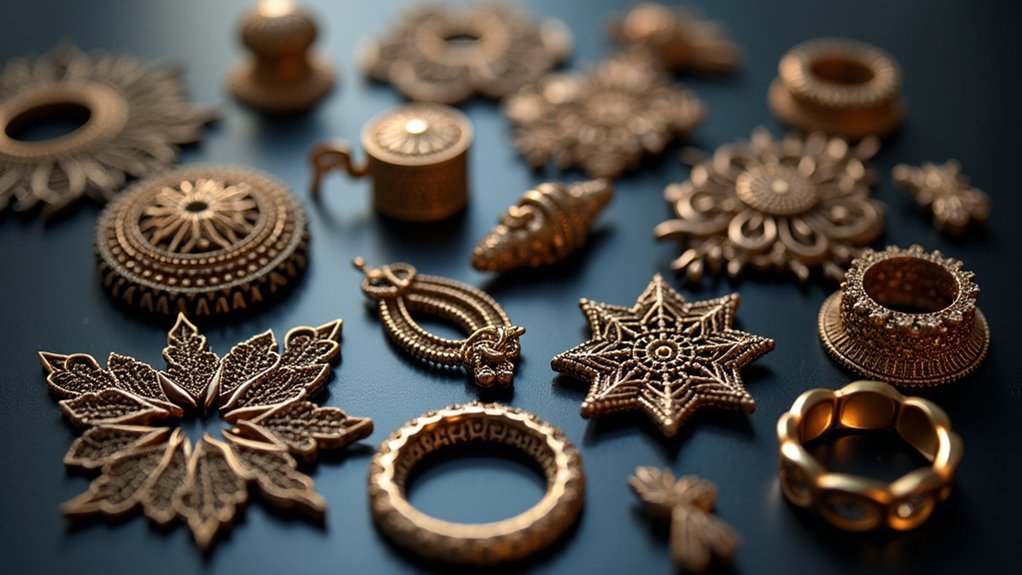
When exploring custom jewelry designs, 3D printing transforms how you’ll evaluate materials and textures throughout your creative process. This technology lets you quickly test various materials like resins, metals, and plastics, giving you hands-on experience with different textures before committing to final production.
The precision of 3D printing guarantees your intricate designs maintain accurate surface details across material samples, enabling effective comparisons.
You’ll benefit from three key advantages:
- Rapid prototyping capabilities provide immediate feedback on material choices
- Lightweight materials like nylon create prototypes that mimic wearability and comfort
- Multiple iterations allow exploration of innovative material combinations and finishes
This efficient testing process speeds up your decision-making while enhancing design quality, ultimately leading to more unique customization possibilities for your jewelry pieces.
Bringing Intricate Digital Concepts to Life
The leap from digital screen to physical reality represents where 3D printing technology truly excels in jewelry creation.
You’ll discover that intricate designs featuring complex geometries, delicate filigree work, and impossible-to-cast details become achievable through this manufacturing approach. Your digital designs can include interconnected moving parts, hollow chambers, and microscopic surface textures that traditional jewelry manufacturing simply can’t replicate.
Through rapid prototyping, you’ll transform your most ambitious concepts into tangible pieces within hours rather than weeks.
The precision of modern 3D printers captures every nuance of your CAD models, from the finest engravings to the most elaborate structural elements. Your material choice further enhances these possibilities, whether you’re working with precious metals, resins, or experimental composites that push creative boundaries beyond conventional limitations.
Faster Time-to-Market for New Designs
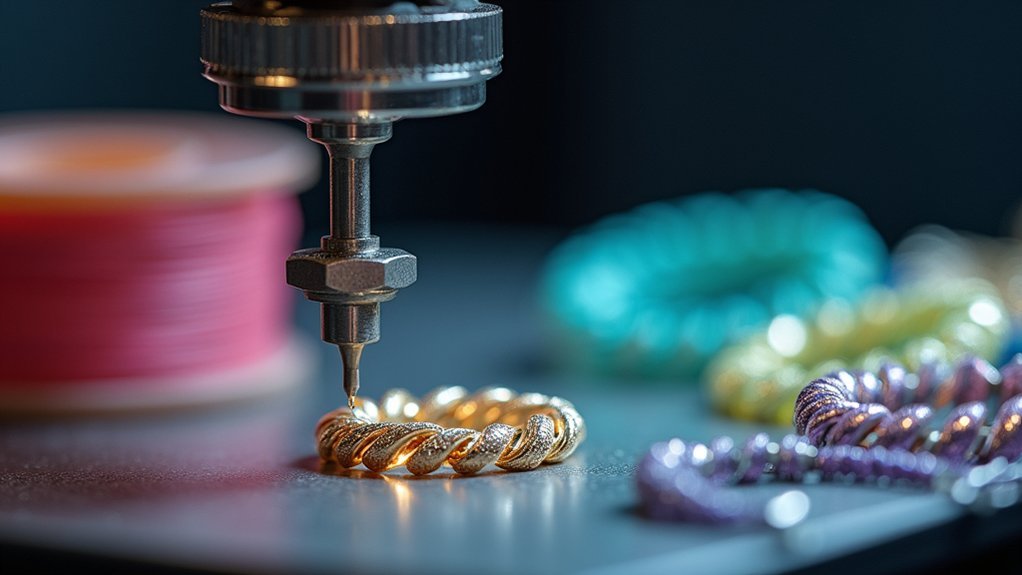
While traditional jewelry manufacturing locks you into lengthy production cycles, 3D printing revolutionizes your design timeline by compressing what once took months into mere days.
3D printing transforms jewelry creation from months-long waits into lightning-fast production cycles that keep pace with your creativity.
This faster time-to-market advantage transforms how you approach custom jewelry designs, eliminating bottlenecks that previously hindered your creative process.
Rapid prototyping enables multiple iterations without the constraints of traditional mold-making, while on-demand production lets you respond instantly to market demands.
You’ll benefit from:
- Simultaneous testing – Print various design variations at once to accelerate decision-making
- Immediate corrections – Identify and fix flaws quickly during development phases
- Trend responsiveness – Launch new collections as soon as designs are finalized
3D printing’s elimination of setup times gives you unprecedented flexibility, ensuring your innovative concepts reach customers while trends remain relevant and profitable.
Accessibility for Independent Jewelry Designers
Breaking down traditional barriers that once separated amateur creators from professional jewelers, 3D printing technology puts sophisticated design capabilities directly into your hands as an independent designer.
You’ll find that user-friendly design software democratizes the entire creative process, eliminating the need for extensive technical training. Affordable 3D printers integrate seamlessly into small-scale operations, slashing your initial investment costs dramatically.
On-demand printing services remove the burden of expensive molds and tooling, letting you experiment with prototyping without financial risk. This accessibility encourages bold experimentation with customization options that respond to unique customer preferences.
Online platforms provide instant quotes and production capabilities, empowering you to bring designs to market efficiently while maintaining complete creative control over your jewelry line.
Quality Control Through Design Iteration
You’ll discover design flaws early when you create rapid prototypes through 3D printing, allowing you to test multiple iterations before committing to final production.
This process lets you examine every detail of your jewelry piece in physical form, catching issues that mightn’t be apparent in digital models alone.
Rapid Prototype Testing
Three key advantages emerge when you integrate rapid prototyping into your jewelry design workflow: immediate physical feedback, accelerated iteration cycles, and quality assurance before production.
3D printing transforms your design process by letting you hold, examine, and test physical models within hours rather than weeks.
This streamlined approach delivers measurable benefits:
- Faster Design Validation – You’ll identify and correct design flaws immediately, preventing costly production errors.
- Enhanced Client Collaboration – Physical prototypes enable precise client feedback, ensuring alignment with expectations.
- Reduced Time-to-Market – Multiple design variations can be tested rapidly, accelerating your overall timeline.
Your production efficiency increases dramatically when you can refine prototypes before committing to large-scale manufacturing.
This methodology enhances customer satisfaction by delivering pieces that perfectly match your original vision and client requirements.
Design Flaw Detection
When you transform digital concepts into tangible prototypes, hidden design flaws become immediately apparent that would otherwise remain undetected until costly production phases. 3D printing empowers you to conduct thorough quality assessments by physically examining every surface detail, joint connection, and structural element of your jewelry piece.
Design flaw detection through rapid prototyping revolutionizes your jewelry production workflow. You’ll identify structural weaknesses and aesthetic inconsistencies before committing to final manufacturing. Iterative testing enables swift adjustments, ensuring high precision in every design element.
| Traditional Methods | 3D Printing Advantage |
|---|---|
| Expensive late-stage corrections | Early flaw identification |
| Limited design variations | Multiple prototype testing |
| Extended development cycles | Rapid iteration capabilities |
| Higher production risks | Confident final manufacturing |
This systematic approach streamlines your design process while minimizing costly errors.
Frequently Asked Questions
How Is 3D Printing Used in Jewelry Making?
You’ll use 3D printing in jewelry making by creating digital CAD models, then printing with SLA or SLM technologies. You can rapidly prototype designs, reduce material waste, and create intricate patterns impossible with traditional methods.
Is It Safe to Wear 3D Printed Jewelry?
You can safely wear 3D printed jewelry when it’s made from biocompatible materials like FDA-approved resins or metals. Choose quality printing services and guarantee proper post-processing to avoid skin irritation.
Is It Worth Selling 3D Printed Items?
You’ll find selling 3D printed items profitable due to low startup costs, high customization demand, and minimal inventory requirements. You can quickly test markets, iterate designs, and achieve better profit margins than traditional manufacturing methods.
What Are the Pros and Cons of 3D Printing?
You’ll find 3D printing offers cost-effectiveness, design freedom, and material efficiency as major pros. However, you’ll face cons like limited material options, surface finish requirements, and potential durability concerns compared to traditional manufacturing methods.
In Summary
You’ve seen how 3D printing transforms jewelry design from concept to creation. You’re no longer bound by traditional manufacturing limits—you can create intricate geometries, prototype rapidly, and customize pieces without expensive tooling. You’ll reduce waste, accelerate your time-to-market, and iterate designs until they’re perfect. Whether you’re an independent designer or established brand, you can now bring your most ambitious digital concepts to life affordably and efficiently.

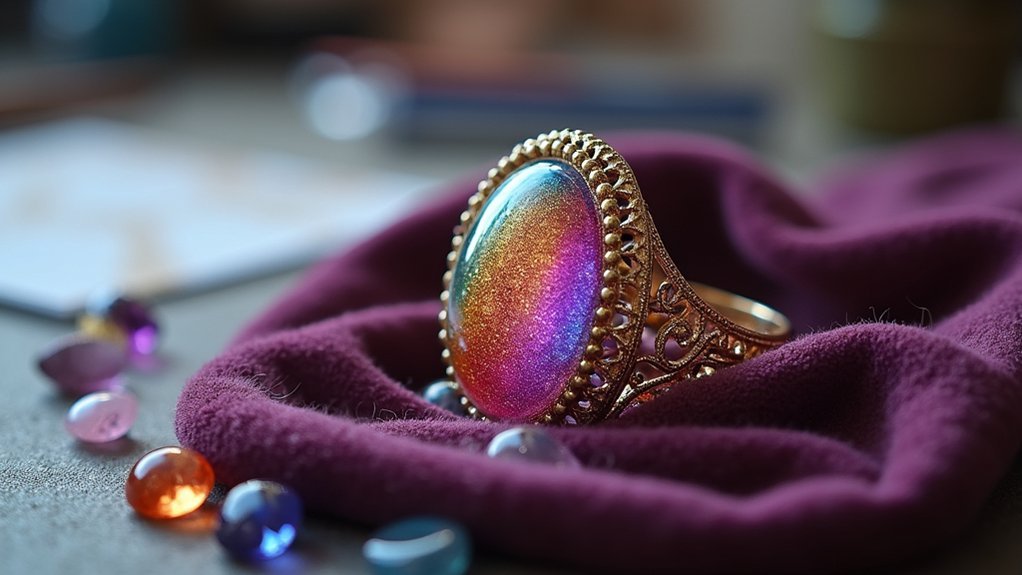
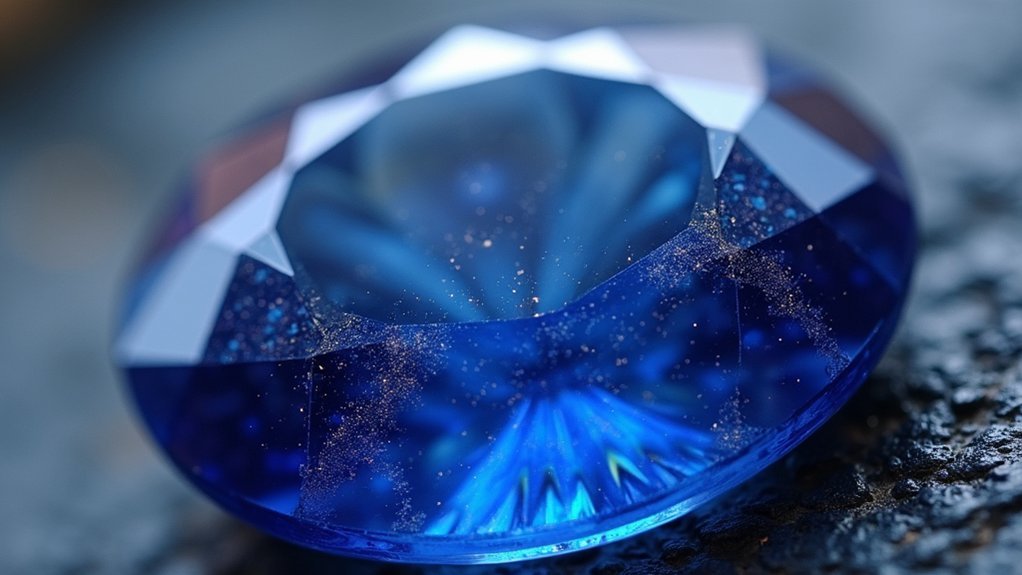

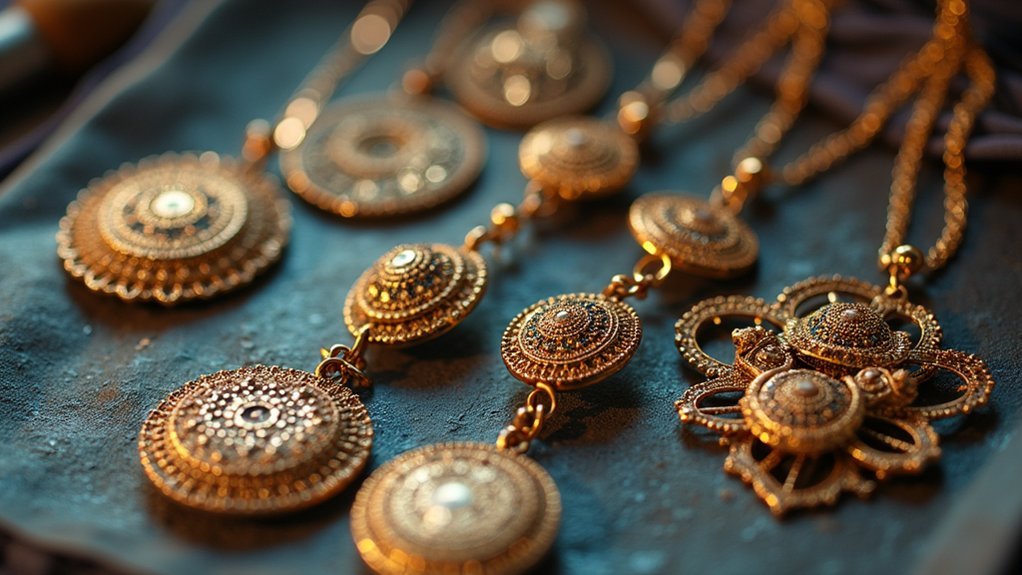
Leave a Reply